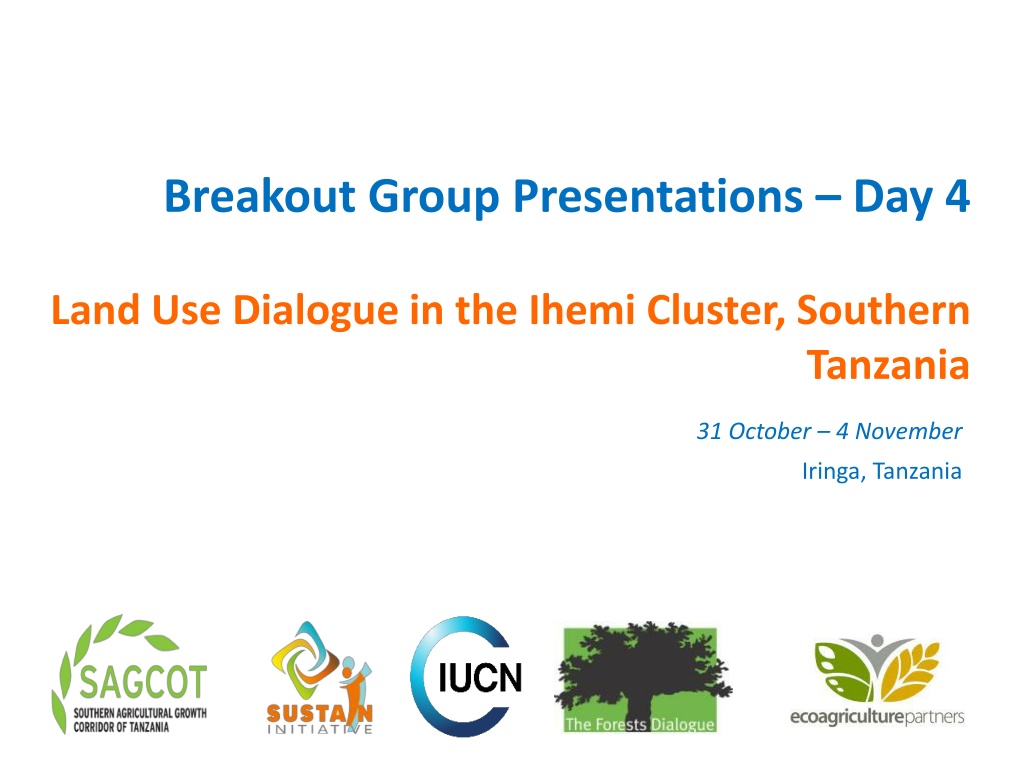Land Use Dialogue in the Ihemi Cluster, Southern Tanzania - Group Presentations and Recommendations
The breakout group presentations from Day 4 of the Land Use Dialogue in the Ihemi Cluster, Southern Tanzania, focused on key tasks, stakeholders, funding sources, and policy influence strategies to address land use issues. Recommendations included stakeholder mapping, workshops, field visits, and awareness creation. Involving the Land Use Task force, government, NGOs, and the community was emphasized for effective implementation. Funding efforts were to be facilitated by IUCN, with a direct connection to the government for policy influence through advocacy activities.
Download Presentation

Please find below an Image/Link to download the presentation.
The content on the website is provided AS IS for your information and personal use only. It may not be sold, licensed, or shared on other websites without obtaining consent from the author. Download presentation by click this link. If you encounter any issues during the download, it is possible that the publisher has removed the file from their server.
E N D
Presentation Transcript
Breakout Group Presentations Day 4 Land Use Dialogue in the Ihemi Cluster, Southern Tanzania 31 October 4 November Iringa, Tanzania
Breakout Group #1 Question 1 31 October 4 November Iringa, Tanzania
Building on existing initiatives and to address the issues raised: -What key task need to be undertaken -What key stakeholders need to be involved -What would be the source of funding -How can we use those to influence policy
Answers Key task need to be undertaken Identifying and Mapping of stakeholders initiatives in order to define roles and responsibilities Linking of different stakeholders initiatives GRG will take lead of the above tasks Developing of TOR and Actions Designed monitoring frame work
key stakeholders need to be involved Land Use Task force Government Non Governmental Organization Community
Source of funding IUCN facilitate fundraising efforts
How can we use those to influence policy GRG has direct connection to government Develop joint advocacy package for SAGCOT to take forward.
Breakout Group #2 Question 2 31 October 4 November Iringa, Tanzania
Involvement of Actors participation and inclusiveness
Key tasks to be done Stakeholder mapping-roles and responsibilities Workshops/Forums/Conferences for stakeholders Organizing field visits to the landscapes of interest Conducting baseline survey to identify weaknesses, opportunities, strengths, and threats for engagements Awareness creation
Actors: ACTORS ROLES National Government Policy formulation, legislations and programmes Regional administration Coordination/Supervision Local government Technical support, planning and execution at respective level FBOs Awareness creation CSO-NGOs/CBOs Advocacy and awareness creation Communities (groups) Planning and implementation Development Partners e.g. USAID, JICA, SIDA, World Bank Funding, programming Investors/Private Sector Funding and execution Media Advocacy and awareness creation Academia Research, programmes and out- reach, technical advancement
Funding Sources Government Budget Development Partners Investors/Private Sector Communities-e.g. Pastoralists
How to influence policy Through research or data collection that informs policy decisions Through financing Through advocacy and awareness creation Through law enforcement
Breakout Group #3 Question 3 31 October 4 November Iringa, Tanzania
Question 3: Need for collaborative platforms How do you coordinate stakeholders through various platforms?
Existing platforms need. To improve coordination Make themselves more visible to a variety of stakeholders Develop clear information flows to all stakeholders.
Key tasks to be undertaken at cluster level Need an analysis of the what platforms exist at the cluster level Is there a good alignment of existing platforms? Where are they mutually supportive? Are all aspects of landscape issues being addressed? Are stakeholders aware of existing platforms? Goal to most effectively utilize resources Risk of multiplying platforms
Identified NEED For a mechanism at the cluster level to ensure coordination of monitoring of actions and sharing of knowledge of successful practices Link this to the Green Reference Group at Ihemi cluster? SUSTAIN can have a role in helping with the monitoring and learning Ensure existence of feedback loops so that knowledge is shared across clusters up to corridor level and down to actions on the ground. This is a key leverage point for influence practice and policy Is the Green Reference Group central in this process?
The Green Reference Groups is the critical stakeholder for coordinating action of the Inclusive Green Growth Importance to ensure they are inclusive? Is funding secure at various levels?
Need to be aware of emerging issues That may be stakeholders that fall between the gaps that may require new platforms urbanization of rural areas involvement of women in agribusiness. These emerging areas
Breakout Group #4 Breakout Group #4 Question 4 Question 4 31 October 4 November Iringa, Tanzania
GROUP 4: QUESTIONS: 1 KEY TASKS TO BE UNDERTAKEN RESOURCES: Land/soil, Wetland, Water resources, Forests, Wildlife, Rangelands, etc Our focus resources: Land/soil, Wetlands, Water resources Land/soil: Best farming practices, Support from extension services, Agro-forestry, Diversification of agriculture, Best agricultural inputs, Awareness to small holder farmers, Organic farming, Mixed Land use to integrate planted forest, agriculture and cattle farming, Sustainable rangeland strategies like restoration and improvement rangeland practices,
WATER RESOURCES Sustainable way to construct water reservoir. Rainfall harvest technologies. Monitoring water sources like River gauging stations, Alternative irrigation systems like Drip irrigations, Catchment restorations like tree planting, Law enforcement and provide alternatives ways, and demonstration. Institution capacity building like RBWO, etc
WETLANDS Wetlands restoration and give alternatives livelihoods Monitoring water sources like River gauging stations, Alternative irrigation systems like Drip irrigations, Catchment restorations like tree planting, Law enforcement and provide alternatives ways, and demonstration. Institution capacity building like RBWO, etc
STAKEHOLDERS Land/soil: Ministry of Land, District Land office, National LUP commission, Ward Land councils, Private sectors, CSOs/NGOs, Village Land committees, Donors and Development partners like Financial institutions, USAID, etc Water Resources/ Wetlands resources : Ministry of water, District Water office, RBWO, USAID, UK AID, etc
POLICY Should be fixed into National specific policies for mainstreaming.



































